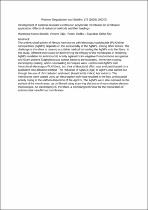 ResearchSpace
ResearchSpace
Development of bacterial-resistant electrospun polylactide membrane for air filtration application: Effects of reduction methods and their loadings
JavaScript is disabled for your browser. Some features of this site may not work without it.
- ResearchSpace
- →
- Research Publications/Outputs
- →
- Journal Articles
- →
- View Item
| dc.contributor.author |
Selatile, Mantsopa K

|
|
| dc.contributor.author |
Ojijo, Vincent O

|
|
| dc.contributor.author |
Sadiku, R

|
|
| dc.contributor.author |
Ray, Suprakas S

|
|
| dc.date.accessioned | 2020-06-10T12:01:55Z | |
| dc.date.available | 2020-06-10T12:01:55Z | |
| dc.date.issued | 2020-05 | |
| dc.identifier.citation | Selatile, M.K. (et.al). 2020. Development of bacterial-resistant electrospun polylactide membrane for air filtration application: Effects of reduction methods and their loadings. Polymer Degradation and Stability, v178, 10pp. | en_US |
| dc.identifier.issn | 0141-3910 | |
| dc.identifier.issn | 1873-2321 | |
| dc.identifier.uri | https://www.sciencedirect.com/science/article/pii/S0141391020301373 | |
| dc.identifier.uri | https://doi.org/10.1016/j.polymdegradstab.2020.109205 | |
| dc.identifier.uri | http://hdl.handle.net/10204/11456 | |
| dc.description | Copyright: 2020 Elsevier. This is the abstract version of the article. For the full text version, please contact the publisher's website. | en_US |
| dc.description.abstract | The antimicrobial activity of fibrous membranes with electrospun polylactide (PLA)/silver nanoparticles (AgNPs) depends on the accessibility of the AgNPs, among other factors. The challenge is therefore to develop a suitable method for loading the AgNPs onto the fibers. In this study, different techniques for determining the efficacy of the membranes in rendering AgNPs available for antimicrobial activity against Gram-negative Pseudomonas aeruginosa and Gram-positive Staphylococcus aureus bacteria are evaluated. Immersion coating, electrospray-coating, and in-situ loading techniques were used to load AgNPs onto hierarchical electrospun PLA fibers, and their antibacterial effect was evaluated based on a qualitative disc diffusion method. The reduction of AgNO3 (Agþ) to AgNPs was carried out through the use of UV irradiation and neem (Azadirachta indica) leaf extracts. The membranes were coated using an electrospray technique resulted in the best antibacterial activity owing to the uniform dispersion of the AgNPs. The AgNPs were also exposed on the surface of the membranes, as confirmed using scanning electron and transmission electron microscopes. An electrospray is, therefore, a promising technique for the preparation of antimicrobial nanofibrous membranes. | en_US |
| dc.language.iso | en | en_US |
| dc.publisher | Elsevier | en_US |
| dc.relation.ispartofseries | Worklist;23544 | |
| dc.subject | Nanofibrous membranes | en_US |
| dc.subject | Immersion coating | en_US |
| dc.subject | Antibacterial | en_US |
| dc.title | Development of bacterial-resistant electrospun polylactide membrane for air filtration application: Effects of reduction methods and their loadings | en_US |
| dc.type | Article | en_US |
| dc.identifier.apacitation | Selatile, M. K., Ojijo, V. O., Sadiku, R., & Ray, S. S. (2020). Development of bacterial-resistant electrospun polylactide membrane for air filtration application: Effects of reduction methods and their loadings. http://hdl.handle.net/10204/11456 | en_ZA |
| dc.identifier.chicagocitation | Selatile, Mantsopa K, Vincent O Ojijo, R Sadiku, and Suprakas S Ray "Development of bacterial-resistant electrospun polylactide membrane for air filtration application: Effects of reduction methods and their loadings." (2020) http://hdl.handle.net/10204/11456 | en_ZA |
| dc.identifier.vancouvercitation | Selatile MK, Ojijo VO, Sadiku R, Ray SS. Development of bacterial-resistant electrospun polylactide membrane for air filtration application: Effects of reduction methods and their loadings. 2020; http://hdl.handle.net/10204/11456. | en_ZA |
| dc.identifier.ris | TY - Article AU - Selatile, Mantsopa K AU - Ojijo, Vincent O AU - Sadiku, R AU - Ray, Suprakas S AB - The antimicrobial activity of fibrous membranes with electrospun polylactide (PLA)/silver nanoparticles (AgNPs) depends on the accessibility of the AgNPs, among other factors. The challenge is therefore to develop a suitable method for loading the AgNPs onto the fibers. In this study, different techniques for determining the efficacy of the membranes in rendering AgNPs available for antimicrobial activity against Gram-negative Pseudomonas aeruginosa and Gram-positive Staphylococcus aureus bacteria are evaluated. Immersion coating, electrospray-coating, and in-situ loading techniques were used to load AgNPs onto hierarchical electrospun PLA fibers, and their antibacterial effect was evaluated based on a qualitative disc diffusion method. The reduction of AgNO3 (Agþ) to AgNPs was carried out through the use of UV irradiation and neem (Azadirachta indica) leaf extracts. The membranes were coated using an electrospray technique resulted in the best antibacterial activity owing to the uniform dispersion of the AgNPs. The AgNPs were also exposed on the surface of the membranes, as confirmed using scanning electron and transmission electron microscopes. An electrospray is, therefore, a promising technique for the preparation of antimicrobial nanofibrous membranes. DA - 2020-05 DB - ResearchSpace DP - CSIR KW - Nanofibrous membranes KW - Immersion coating KW - Antibacterial LK - https://researchspace.csir.co.za PY - 2020 SM - 0141-3910 SM - 1873-2321 T1 - Development of bacterial-resistant electrospun polylactide membrane for air filtration application: Effects of reduction methods and their loadings TI - Development of bacterial-resistant electrospun polylactide membrane for air filtration application: Effects of reduction methods and their loadings UR - http://hdl.handle.net/10204/11456 ER - | en_ZA |





